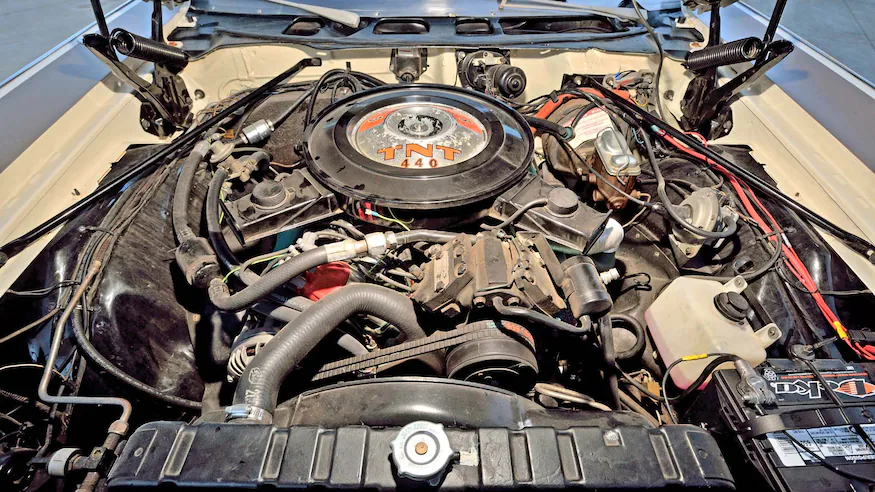1970 Chrysler Hurst 300
Country of Origin: USA
Design Info: A massive slab of personal luxury, the 1970 Chrysler 300 has been labeled “boatlike” by some journalists, and with a hood that goes on forever and a trunk seemingly bigger than some apartments, the 4300 lb, 18½ft car is inescapably gargantuan. The interior of the Hurst models was largely pulled from the top-of-the-line Imperial. However, its crisp lines, wide grill and hidden headlights create an image imposing and even sporty, rather than soft. The Hurst additions, including lightweight fiberglass hood and rear endcap, integrated spoiler, and golden accents enhanced the notion that this was a muscle car – one of the largest ever built.
Engine Info: Hurst 300s were exclusively built with the potent Chrysler RB 440 “wedge”, a 7.2 liter V8 rated at 375 HP and 480 lb-ft of torque. In Dodges the engine would be called the Magnum, and in Plymouths it was the Super Commando. In the Chrysler, however, it was called the TNT.
Type: The Chrysler 300 of 1970 was something of an executive muscle car, combining aspects of smaller American performance cars with the personal luxury car segment, creating a car aimed at well-off, mid-30s aged men who wanted both. Similar contemporaries included the Pontiac Grand Prix, Oldsmobile Toronado, the Chevrolet Impala SS, and the Mercury Marauder X-100.
History: While the Chrysler 300 letter-series ended after 1965, the 300 itself had soldiered on. In 1969, the 6th generation 300 was released, featuring the new “fuselage” styling that Chrysler had shown off the year before. Meant to evoke big jet airliners, the “fuselage” cars presented a somewhat rounded cross section, narrower at the roof and widest at the middle bodyline. The look was crisp, but not universally appealing.
An idea to create better appeal, more visibility, was to create a special edition of the car, something special for promotion, a limited production run to turn heads and bring people into dealerships. Hurst, who had already done the high profile Hurst/Oldsmobiles in ‘68 and ‘69, as well flashy Hurst SC/Rambler with AMC, approached Chrysler with a pitch to build a higher performance muscle car version of the 300. When the deal was made, Chrysler planned to send 2000 assembled 300s to Hurst for mechanical and visual modification, and then onward to their dealers. The cars would mount the more powerful of the two available engines, the well-respected 440, and would have a top-tier luxurious interior. Additionally, planned modification of the trunk meant that there would be no lock cylinder; as such, the Hurst 300s would be fitted with a vacuum tube trunk release button inside the glove box.
Unfortunately, problems arose immediately with production. Delayed project approval meant that the Hurst 300 (or 300H) wasn’t available for release at the beginning of the model year. Additionally, when the cars finally reached Hurst for modification the planned mechanical changes were nixed. While they still received lightweight hoods and fiberglass spoilers, the cars ironically lacked the primary feature Hurst was known for: the floor-mounted shifter.
The biggest issue for the Hurst 300, however, was likely the fact that it remained largely unknown during its production run. Chrysler expected Hurst to promote the car, but Hurst thought Chrysler would do it. While the single 300 Hurst convertible was driven at some promotional events, often with Miss Hurst Golden Shifter (“The First Lady of Motorsports”) Linda Vaughn riding along, the car was so poorly promoted even dealers sometimes did not know of its existence until one showed up on their lot. Of the planned 2000 units, only around 500 were built in the single year of its production. The 300 was dropped from the Chrysler lineup a year later, and would not return until 1999 with the 300M (with exception to a single year trim option in 1979 on the Chrysler Cordoba).
Why it’s cool/unique/significant: Niche cars are always a little weird, built for a small and usually hyperspecific market. The Chrysler 300 of 1970 was not so unusual as a full-size luxury car, but the Hurst model’s muscle car performance made it much more unique. It is one of (if not THE) largest muscle cars ever built, and possibly the best looking example of a short but iconic “fuselage” era of Chrysler design. It also continued an important legacy of power performance in the Chrysler brand, from the original Hemi powered C-300 of 1955 to the modern (and likely final) V8 powered 300C of today.




